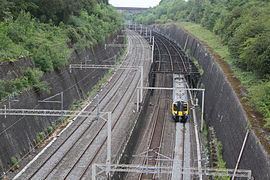Type Heavy rail Status Operational Opened 1881 | Stations Two | |
 | ||
Locale NorthamptonshireEast MidlandsWest Midlands (region) | ||
Platform 13 presents northampton loop mpg
The Northampton loop is a railway line serving the town of Northampton. It is a branch of the West Coast Main Line, deviating from the faster direct main line which runs to the west. The WCML is a four track line up to either end of the Loop: the 'up' and 'down' fast tracks take the direct route while the 'up' and 'down' slow tracks are diverted via Northampton railway station.
Contents
- Platform 13 presents northampton loop mpg
- Northampton loop variety 7th 9th june 2016
- Services and operations
- History
- Stations
- Proposed future development
- Accidents and incidents
- References
The southern interconnect between the Northampton loop and the direct London–Birmingham main line is at Hanslope Junction, just north of Milton Keynes. The lines continue to run alongside until the two routes diverge north of Roade at the northern end of Roade cutting. The loop line then runs north east for several miles until it reaches Northampton station. After Northampton, the line heads to the north-west for around twenty miles, until it re-joins the main line at Hillmorton Junction at Rugby, just east of Rugby station. The line is a total of 23 3⁄4 miles (38.2 km) long.
Northampton loop variety 7th 9th june 2016
Services and operations
The majority of passenger services on the line are provided by London Midland using Class 350 electric multiple units. Class 319 units are used for peak-hour express services between Northampton and London Euston. The service consists of three 'semi fast' trains per hour between London Euston and Birmingham New Street. There is also an hourly local service between Northampton and Birmingham. Prior to December 2012 there was also a service to and from Crewe, but a few serve the loop line during morning and evenings and hourly on Sundays.
Virgin Trains provide a small number of Pendolino services to London at the extremes of the day. But nearly all Virgin trains use the direct main line. Line speeds on the loop line are currently limited to 75 mph (120 km/h) compared to 125 mph (200 km/h) on the fast line, making the line unattractive to the routing of fast services. As of 2011, line speeds were expected to increase to 90 mph (140 km/h) once signalling improvements are in place north of Northampton up to Rugby.
Long Buckby; the one other station on the line, is served by the London–Birmingham/Northampton–Birmingham services. The London–Crewe service does not stop at Long Buckby except on Sundays.
The line sees heavy freight traffic, as it is used by all freight trains on the southern part of the WCML. Many of these are container trains, with some serving the Daventry International Railfreight Terminal (DIRFT), which is between Northampton and Rugby (thus on the loop line).
History
When the London and Birmingham Railway (L&BR) was constructed in the 1830s, Northampton was by-passed, with the line running on high ground to the west via Kilsby Tunnel. Traditionally this was said to have been because Northampton landowners objected to having a railway run to the town. However, more recently, railway historians have argued that Northampton was by-passed because the gradients would have been too steep for early locomotives to easily cope with. Robert Stephenson the engineer of the London and Birmingham Railway was determined to avoid gradients steeper than 1:330. As Northampton is located in the Nene Valley, 120 feet (37 metres) lower than Blisworth, the closest point the L&BR came, connecting the town would have required gradients steeper than this.
This meant however that Northampton, despite being a large town, did not have direct rail links to London. A branch from the main line was built to Northampton in the early 1840s, the Northampton and Peterborough Railway, from Blisworth, which gave the town indirect rail links to London and Birmingham.
The loop line was constructed in the late 1870s by the London and North Western Railway and was opened in 1881 (by this stage locomotives had become far more powerful). It was constructed to improve rail services to Northampton and give the town a direct link to London. It also had the advantage of doubling capacity on the line from Roade to Rugby without the expense of widening the tunnel at Kilsby.
The line was electrified along with the rest of the WCML during the 1960s in the wake of the BR 1955 Modernisation Plan.
Stations
The only stations that are currently operational on the route are Northampton and Long Buckby. Previously there were five stations on the loop line, but only these two survive. The three stations closed were:
Proposed future development
Warwickshire County Council have proposed a new station on the Northampton Loop Line called Rugby Parkway station, which would be on the south-eastern outskirts of Rugby serving the Hillmorton area of the town. The purpose of this would be to accommodate the future expansion of the town. If it goes ahead the new station is planned to open in 2019.
